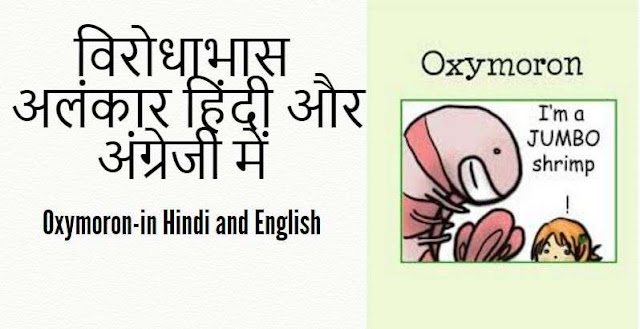विरोधाभास – अलंकार हिंदी और अंग्रेजी में – Oxymoron-in Hindi and English

Contents
विरोधाभास – अलंकार हिंदी और अंग्रेजी में – Oxymoron-in Hindi and English
Oxymoron- ओक्सिमोरोन – विरोधाभाष –विरोधाभाष अलंकार में दो अलग-अलग या विरोधी (Opposite,) शब्दों को एक ही कथन (Statement) में कहा जाता है
Example – Life is a bitter sweet.
Oxymoron- ओक्सिमोरोन – विरोधाभाष – (Oxymoron is the combination of two words of opposite meanings in one expression)
Example – It is an open secret.
Oxymoron (ऑक्सिमोरोन)
An oxymoron is a figure of speech in which two contradictory or opposite words are combined to create a unique or thought-provoking meaning. It involves pairing terms that appear to be opposites but are used together to emphasize an idea, concept, or paradox.
Examples in English:
-
Jumbo shrimp – The word “jumbo” means large, while “shrimp” refers to something small. Together, they form an oxymoron.
-
Deafening silence – Silence is typically associated with quietness, but “deafening” refers to an overwhelming loudness, creating a paradoxical effect.
-
Bitter sweet – Describes something that has both happy and sad aspects at the same time.
-
Living dead – Refers to beings that are technically dead but still display signs of life, like zombies in popular culture.
Examples in Hindi:
-
मौन शोर (Silent noise) – The term “मौन” (silent) and “शोर” (noise) are opposites, but together they describe a situation where silence is unexpectedly loud.
-
अंधेरा उजाला (Dark light) – A combination of “अंधेरा” (darkness) and “उजाला” (light) conveys a contrast.
-
सच्चा झूठ (True lie) – Combining truth (“सच्चा”) and lie (“झूठ”) implies a paradox, something that is both true and false at the same time.
-
ठंडी गर्मी (Cold heat) – “ठंडी” (cold) and “गर्मी” (heat) contradict each other, but used together, they describe a unique feeling or situation.
Definition in Hindi:
ऑक्सिमोरोन (Oxymoron) वह शैली है जिसमें एक ही वाक्य या वाक्यांश में दो विपरीत विचारों या शब्दों को जोड़कर एक विशेष अर्थ या विचार व्यक्त किया जाता है। यह एक साहित्यिक तकनीक है जो परस्पर विरोधी शब्दों को एक साथ लाकर गहरी सोच या प्रभाव उत्पन्न करती है।
Conclusion:
An oxymoron is used in both literature and everyday speech to highlight paradoxes, create irony, or emphasize an unusual or complex situation. Whether in English or Hindi, these combinations of opposites offer a unique way to express contrasting emotions or ideas.
Would you like to explore more examples or details about how oxymorons work?
